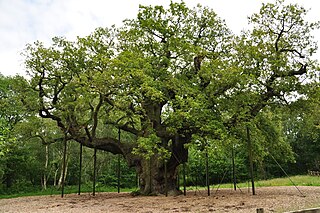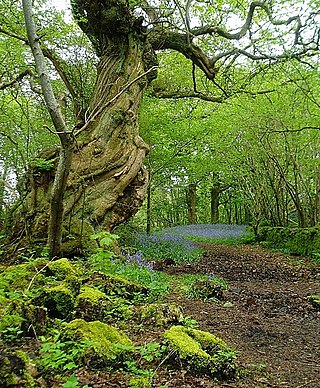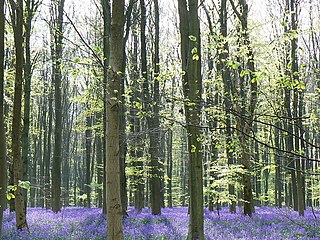Related Research Articles

Sherwood Forest is the remnants of an ancient royal forest in Nottinghamshire, England, having a historic association with the legend of Robin Hood.

Coppicing is the traditional method in woodland management of cutting down a tree to a stump, which in many species encourages new shoots to grow from the stump or roots, thus ultimately regrowing the tree. A forest or grove that has been subject to coppicing is called a copse or coppice, in which young tree stems are repeatedly cut down to near ground level. The resulting living stumps are called stools. New growth emerges, and after a number of years, the coppiced trees are harvested, and the cycle begins anew. Pollarding is a similar process carried out at a higher level on the tree in order to prevent grazing animals from eating new shoots. Daisugi, is a similar Japanese technique.

The Woodland Trust is the largest woodland conservation charity in the United Kingdom and is concerned with the creation, protection, and restoration of native woodland heritage. It has planted over 50 million trees since 1972.

Quercus robur, the pedunculate oak or English oak, is a species of flowering plant in the beech and oak family, Fagaceae. It is a large tree, native to most of Europe and western Asia, and is widely cultivated in other temperate regions. It grows on soils of near neutral acidity in the lowlands and is notable for its value to natural ecosystems, supporting a very wide diversity of herbivorous insects and other pests, predators and pathogens.

The Major Oak is a large English oak near the village of Edwinstowe in the midst of Sherwood Forest, Nottinghamshire, England. According to local folklore, it was Robin Hood's shelter where he and his merry men slept. It weighs an estimated 23 tons, has a girth of 33 feet, a canopy of 92 feet, and is about 800–1,000 years old. In 2014, it was voted 'England's Tree of the Year' by a public poll by the Woodland Trust, receiving 18% of the votes. Its name originates from Major Hayman Rooke's description of it in 1790.

In the United Kingdom, ancient woodland is that which has existed continuously since 1600 in England, Wales and Northern Ireland. Planting of woodland was uncommon before those dates, so a wood present in 1600 is likely to have developed naturally.

Windsor Great Park is a Royal Park of 2,020 hectares, including a deer park, to the south of the town of Windsor on the border of Berkshire and Surrey in England. It is adjacent to the private 265 hectares Home Park, which is nearer the castle. The park was, for many centuries, the private hunting ground of Windsor Castle and dates primarily from the mid-13th century. Historically the park covered an area many times the current size known as Windsor Forest, Windsor Royal Park or its current name. The park is managed and funded by the Crown Estate, and is the only royal park not managed by The Royal Parks. Most parts of the park are open to the public, free of charge, from dawn to dusk, although there is a charge to enter Savill Garden.

Wychwood or Wychwood Forest is a 501.7-hectare (1,240-acre) biological Site of Special Scientific Interest north of Witney in Oxfordshire. It is also a Nature Conservation Review site, Grade 1, and an area of 263.4 hectares is a national nature reserve The site contains a long barrow dating to the Neolithic period, which is a scheduled monument.

Savernake Forest stands on a Cretaceous chalk plateau between Marlborough and Great Bedwyn in Wiltshire, England. Its area is approximately 4,500 acres.
Ansty and Staplefield, previously Cuckfield Rural, is a civil parish in the Mid Sussex District of West Sussex, England, covering an area from the north-west side of Burgess Hill, the whole lying around but mostly to the west of Cuckfield civil parish, from which it was created in 1894 under the Local Government Act 1894. It includes the settlements of Ansty in the south, Staplefield to the north-west and Brook Street to the north-east. It is the largest civil parish in West Sussex, covering an area of 3,869 hectares (14.94 sq mi), and has a population of 1574, increasing to 1,756 at the 2011 Census.

The Capon Oak Tree is one of the last surviving trees of the ancient Scottish Jedforest. It is close to the A68 and Jed Water, a small river which has cut a course below soft sandstone cliffs. The Sessile Oak tree was said to be in the top fifty trees in the UK in 2002 and in the top 10 in 2024.

Bowthorpe Oak in Manthorpe near Bourne, Lincolnshire, is a gigantic and ancient pedunculate oak in England. The tree has a circumference of about 44 feet and has a hollow trunk, making it the second-widest individual tree in the UK, only surpassed by the significantly older and much less-intact Marton Oak in Cheshire. It is commonly thought to be the UK's oldest oak tree on account of its size, although it is surpassed in age by the 1,200-year old Marton Oak, and the 1,300-1,500 year old King Offa's Oak at Windsor.

The United Kingdom, being in the British Isles, is ideal for tree growth, thanks to its mild winters, plentiful rainfall, fertile soil and hill-sheltered topography. In the absence of people, much of Great Britain would be covered with mature oaks as well as savannah-type of plains, except for Scotland. Although conditions for forestry are good, trees face threats from fungi, parasites and pests. Nowadays, about 13% of Britain's land surface is wooded. European countries average 39%, but this varies widely from 1% (Malta) to 66% (Finland). As of 2021, government plans call for 30,000 hectares to be reforested each year. Efforts to reach these targets have attracted criticism for planting non-native trees, or trees that are out of place for their surroundings, leading to ecological changes.

Dymock Woods is a 53-hectare (130-acre) biological Site of Special Scientific Interest in Gloucestershire, notified in 1990. The site is listed in the 'Forest of Dean Local Plan Review' as a Key Wildlife Site (KWS).

Collinpark Wood is a 66.69-hectare (164.8-acre) biological Site of Special Scientific Interest in Gloucestershire, notified in 1966, revised in 1974 and renotified in 1983. There was a boundary change in 1983. There are seven units of assessment. Unit 1 is a 15-hectare (37-acre) area owned and managed by the Gloucestershire Wildlife Trust. The trust purchased this part of the wood in 1979 with grant aid from WWF. The site is listed in the 'Forest of Dean Local Plan Review' as a Key Wildlife Site (KWS).

The Queen Elizabeth Oak is a large sessile oak tree in Cowdray Park near the village of Lodsworth in the Western Weald, West Sussex, England. It lies within the South Downs National Park. It has a girth of 12.5–12.8 metres (41–42 ft), and is about 800–1,000 years old. According to this estimate it began to grow in the 11th or 12th century AD. In June 2002, The Tree Council designated the Queen Elizabeth Oak, one of fifty Great British Trees, in recognition of its place in the national heritage. According to the Woodland Trust, the tree is the third largest sessile oak tree to be recorded in the United Kingdom after the Pontfadog Oak in Wales and the Marton Oak in Cheshire, although this tree is now fragmented.

The Tree of the Year competition is held in the United Kingdom in autumn each year by the Woodland Trust, a nationwide conservation charity. Nominated trees are shortlisted by a panel of experts, before going to public votes to select a tree of the year for each of the four constituent countries of the United Kingdom. The panel then selects one of these to become Britain's tree of the year and be nominated for the following year's European Tree of the Year. The competition has been run each year since 2014.

West Woods is a wood about 2+1⁄2 miles (4 km) southwest of the market town of Marlborough in the English county of Wiltshire, United Kingdom. Its area is approximately 957 acres (387 ha). It is open to the public, and is popular with visitors in the Spring, when bluebells cover the forest floor.
References
- 1 2 "Sessile Oak 'Big-Belly Oak' in Savernake Forest, Marlborough, England, United Kingdom". Monumental Trees. Retrieved 9 October 2023.
- 1 2 "How To Visit The Big Belly Oak, Savernake Forest". Escape To Britain. 2 June 2022. Retrieved 9 October 2023.
- 1 2 "Big Belly Oak". The Woodland Trust. Retrieved 9 October 2023.
- ↑ "Savernake Forest and its Ancient Oaks". Britain Express. Retrieved 9 October 2023.
- ↑ "Monumental trees in Savernake Forest in Marlborough, England, United Kingdom". Monumental Trees. Retrieved 9 October 2023.